by Lisa Cooke | Jul 2, 2019 | 01 What's New, Records & databases |
Genealogical records come in all shapes and sizes and this week’s records round up even includes round records! Keep reading because you never know what you’ll find.
Photographs at Indiana Album
I love this website simply for the tag line Historic Photographs from the attic to the Web! We all have a bit of other families’ genealogy in our attics, closets and scrapbooks, and Indiana Album is a nonprofit organization that want to make it accessible. They encourage Hoosiers (and of course descendants of Hoosiers) to loan them their photos and documents. The group then digitizes, catalogs and shares them in a database on their website. Head here to search for the names, places and other keywords relating to your family. I’m finding gems like the one below.
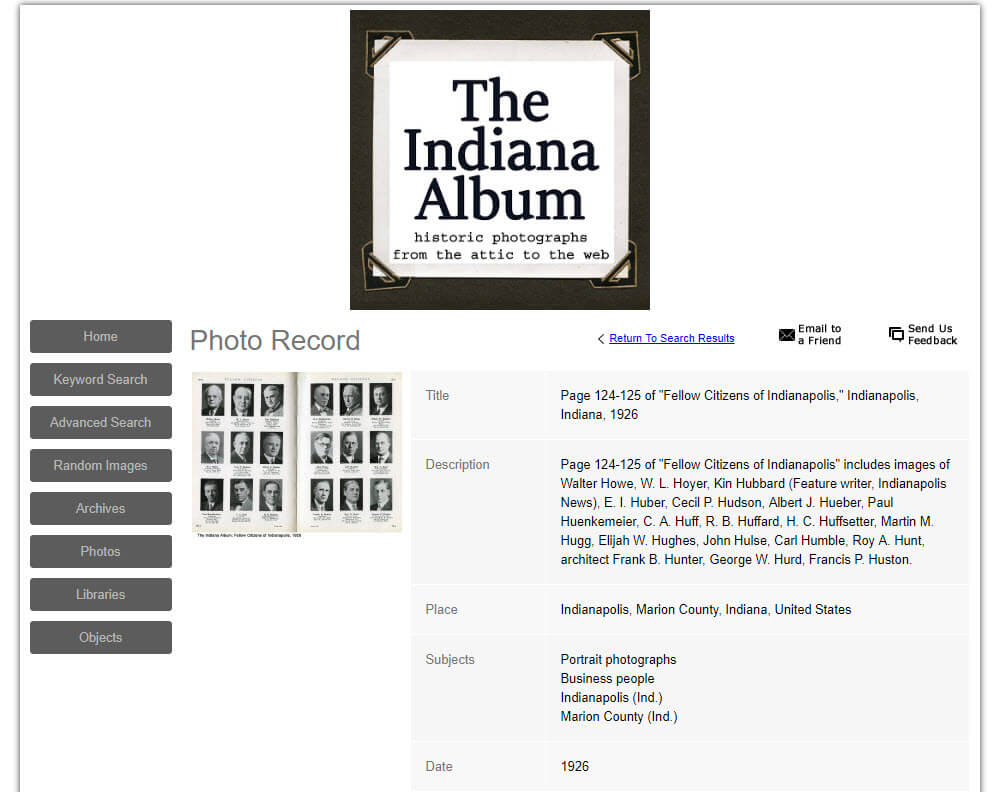
Internet Archive’s Great 78 Project
Here’s a free online collection that is adding tons of new melodic content!
I’m amazed how often I run across music references in my genealogical research, particularly when reviewing the diaries, letters and other records of my late 19th century and early 20th century relatives.
When I was in my twenties I wrote my Grandfather often and asked him questions like “Do you remember any favorite songs from when you were a young man?” His answer included:
As you can see from the linked titles above (click them to listen for yourself), I found every single one of them at the Internet Archive’s Great 78 Project. This is a phenomenal free online collection of digitized recordings made accessible to everyone.
The good news is that the project, which currently boasts over 200,000 recordings, just received funding to preserve another 250,000 sides of 78 rpm records. That means they need records. So, check your basement, closets and attic and consider donating your 78s to the Internet Archive’s Great 78 Project for digitization and physical preservation. You can donate your 78rpm Records to the Internet Archive’s Great 78 Project here.
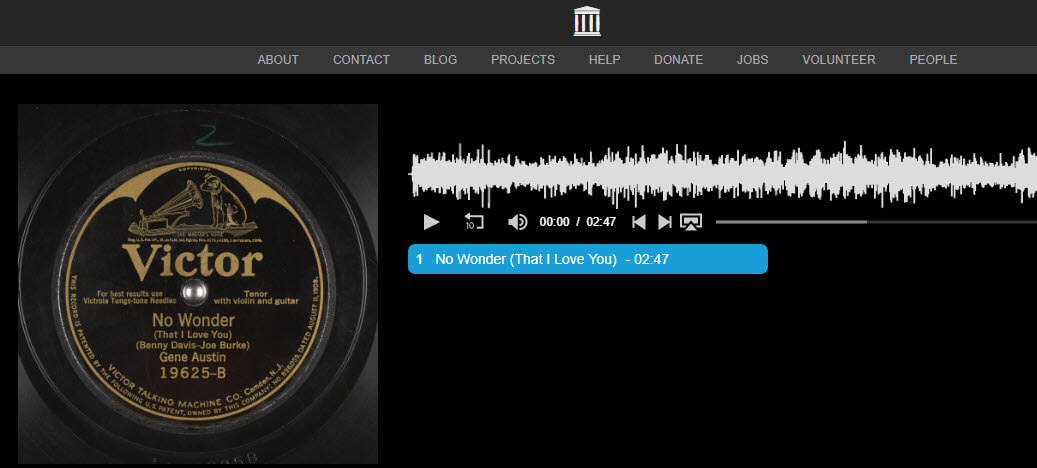
No Wonder (That I Love You) Gene Austin, 1925
UK & Iceland Records at Findmypast
There are over 6.4 million new records and newspaper articles available to search and explore this Findmypast Friday including over 264,000 new and exclusive parish records that have been digitised and made available online for the first time in association with the Lancashire Archives.
Lancashire Baptisms
Over 31,000 additional records are now available to search amongst out collection of Lancashire Baptisms. The new additions cover the parishes of:
- Edge Hill, St Nathaniel -1869 to 1918
- Liverpool, St John – 1785 to 1898
- Liverpool, St Silas, Pembroke Place – 1841 to 1918
- Liverpool, St Stephen the Martyr – 1851 to 1918
- Newburgh, Christ Church – 1860 to 1917
- Seaforth, St Thomas – 1839 to 1918
- Stoneycroft, St Paul – 1916 to 1918
- Toxteth Park, St Bede – 1882 to 1918
These records include both transcripts and images of the original documents. Each result will reveal when and where your ancestor’s baptism took place, the names of their parent’s and father’s occupation.
Lancashire Marriages & Banns
A further 179,000 records have also been added to our collection of Lancashire Banns & Marriages. These new marriage registers add coverage for a selection of new Liverpool parishes, including:
- Edge Hill, St Nathaniel – 1871 to 1943
- Everton, Emmanuel – 1835 to 1943
- Liverpool, St John – 1785 to 1898
- Liverpool, St Stephenn the Martyr – 1852 to 1943
- Seaforth, St Thomas – 1870 to 1943
- Stoneycroft, St Paul – 1916 to 1943
- Toxteth Park, St Bede – 1887 to 1943
Learn when, where and to whom your ancestor was married, as well as the happy couple’s ages, occupations, marital status, residences, parent’s names and father’s occupation.
Lancashire Burials
Over 54,000 new records from the central Liverpool Parish of St John. These new records span the years 1767 to 1883 and will allow you to discover when your Liverpool ancestors were laid to rest.
The transcripts and images within this collection will enable you to discover when your ancestor died, their occupation, the date and location of their burial, as well as their age at death.
United States Obituary Notices
A whopping 5.7 million new records are now available to search within our collection of United States Obituary Notices.
These records, obtained from the tributes.com and currentobituary.com websites will enable you to discover your ancestor’s name, birth and death years as well as the original obituary text. Additional information such as images and details about the records can be found on the source’s website.
Scotland, Darien Scheme Investors 1696
Explore the records of investors in The Company of Scotland Trading to Africa and the Indies, also called the Scottish Darien Company. It was funded by investments from people across Scotland. These transcripts will provide you with information on those who invested money and their representatives.
The Darien scheme was an unsuccessful attempt by the Kingdom of Scotland to establish a colony called “Caledonia” in Panama in the late 1690s. Opposed by commercial interests from England, the company of Scotland raised subscriptions for the scheme in Amsterdam, Hamburg, and London. English investors soon raised their share but withdrew their money after King William and the English Parliament turned against the venture. However, by August 1696 the Scottish investors raised £400,000 themselves.
As the scheme was backed by approximately 20% of all the money circulating in the country at the time, its failure left the entire Lowlands in substantial financial ruin and was an important factor in weakening Scottish resistance to the Act of Union. In July 1699, the colony was abandoned due to inadequate provisions, the unfamiliar hot and humid climate had caused fever to spread, and many settlers died. Of the 1,200 settlers, only 300 survived.
International Records Update – Iceland
To mark Icelandic National Day this week, we have made over 287,000 baptism and marriage records from the land of fire and ice available to search on Findmypast.
These two new indexes span the years 1730 to 1920 and will generate hints against your Findmypast Family tree.
British & Irish Newspaper Update
A bumper crop of new and updated titles have been added to the collection this week, with 163,404 new pages added. We have seven brand new titles added this week, covering both England and Scotland. We have three new London publications joining us – the Harrow Midweek, the Middlesex Gazette and the Middlesex Independent – as well as one Scottish title (the Northern Ensign & Weekly Gazette) and one new Essex title (the Essex Guardian). We are also delighted to welcome two specialist sporting titles – namely, the Volunteer Record & Shooting News, which ‘warmly supports the interests of the shooting man,’ and the Fishing Gazette, a publication which covers all types of fishing across the world.
Further to these new arrivals, we have also updated sixteen of our existing titles. Updates this week cover the length and the breadth of the United Kingdom and Ireland, with updates incorporating publications from Aberdeen to Jersey, from Kingston to County Down, from Bristol to Kensington, from Crawley to Strabane.
Navy Officer Letters at Fold3
Fold3 just announced “We have added a new collection of naval records to our archives! The Navy Officers’ Letters 1802-1884 is a collection of letters to the Secretary of the Navy from officers assigned to naval ships, stations, and Navy bureaus.
The letters contain routine personnel matters such as duty assignments, leave or furloughs, desertions, resignations, court-martials, and other administrative issues. The collection is organized by year and then alphabetically by sender. The letters offer a glimpse into military history and provide valuable genealogical records for ancestors that served in the Navy.”
British Newspaper Archive
This week the British Newspaper Archive added 137,896 new pages spanning 128 years from 1871 to 1999 to eighteen of their existing collections. These include extensive updates to the Walsall Observer, and South Staffordshire Chronicle, which cover the years 1873 to 1969 and includes nearly 35,000 pages.
Also updated: Six of their London titles, including the Acton Gazette, as well as three Scottish titles, with pages added to the Hamilton Advertiser, the Dumfries and Galloway Standard and the Aberdeen Press and Journal. We have added pages to publications covering Newcastle and Middlesbrough, as well as new pages to The People.
A subscription is required. Clicking on the titles above allows you to see examples and review the scope of the collection.
Full Disclosure: We appreciate when you use our links because if and when you subscribe we are compensated, which helps support this free blog and the free Genealogy Gems Podcast.
by Lisa Cooke | Jun 27, 2019 | 01 What's New, Copyright, Digital Archives, Photographs
Historical photos and images can bring depth and understanding to genealogical findings. In the case of sharing your family history with others in your family who don’t share your passion for genealogy, they are an essential part of bringing family history to life.
One of the best free online resources for historical photos is the Creative Commons at Flickr.
Flickr is a popular photo, image and video hosting and sharing service. It’s a great platform for sharing your favorite photos with family and friends. It’s also an excellent place to find images that fit into your family history.
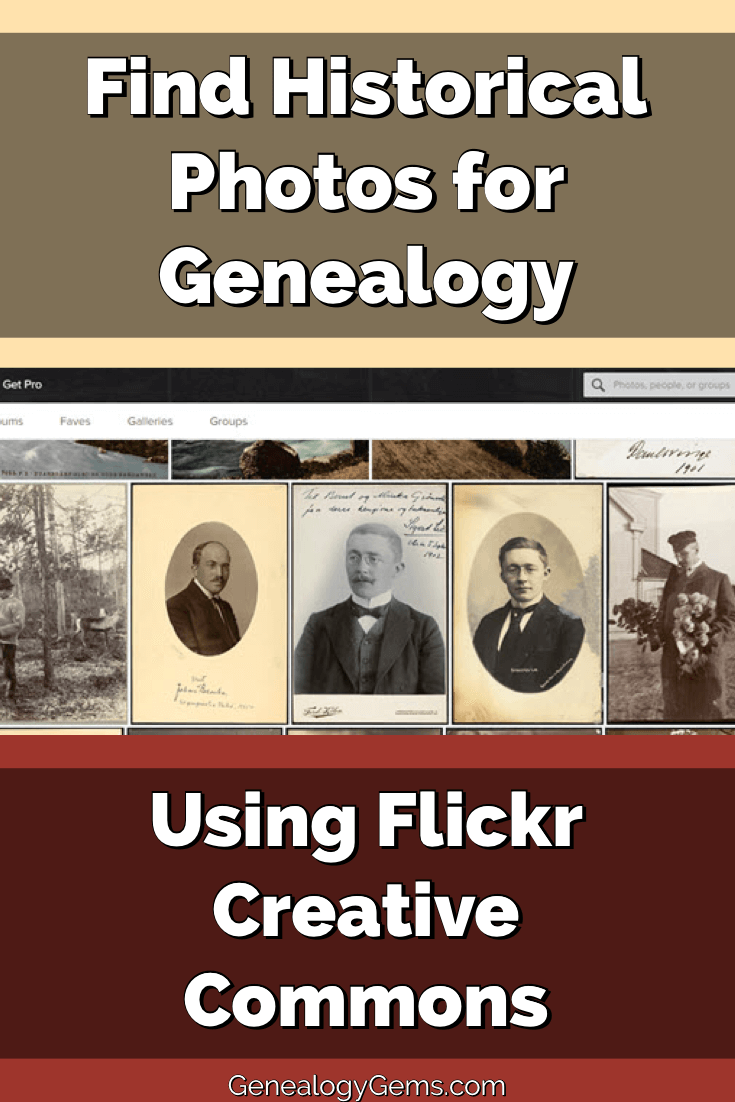
An important part of the Flickr world is Creative Commons, which describes itself as part of a “worldwide movement for sharing historical and out-of-copyright images.”
Groups and individuals alike upload old images, tag and source them, and make them available to others through the Creative Commons. And when it comes to groups, the list of participants is impressive.
The British Library photostream features over a million images in its photostream! And a robust collection of historical photos and images can be found at the (U.S.) Library of Congress photostream, with over 34,000+ photos.
Searching the Creative Commons
When searching the Creative Commons, be sure to look for your favorite libraries and historical societies. If you don’t find them today, don’t worry. Check back regularly because new content is being added all the time.
Here’s another example of what you can find at the Creative Commons. The Netherlands Institute of Military History (Nederlands Instituut voor Militaire Historie) has a photostream.
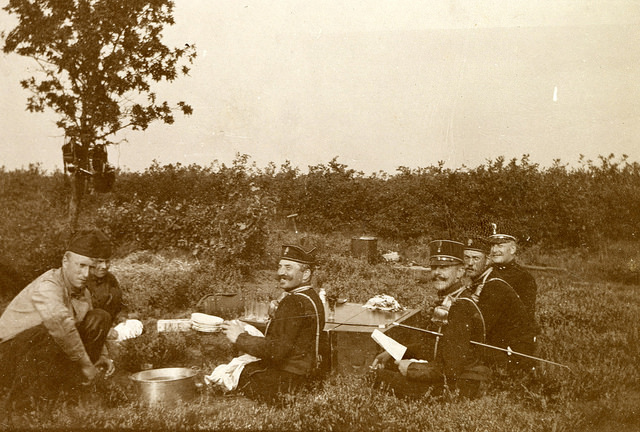
“Exercise Field Artillery Corps” album, image AKL092038, Netherlands Institute of Military History uploads at Flickr Creative Commons, https://www.flickr.com/photos/nimhimages/16026248719/.
According to the Netherlands Institute of Military History blog, “The Institute exists to serve all those with an interest in the military past of the Netherlands. Its sphere of activities covers the Dutch armed forces on land, at sea and in the air, from the sixteenth century until now. The staff of the NIMH administer a unique military history collection containing approximately 2 million images, of which they will be uploading many to the site.”
Back in 2015 when we first wrote about their brand new photostream it only included a couple dozen images, like the one shown here. Today they have well over 3,300.
Tips for Finding and Using Historical Photos at the Creative Commons
Searching for Historical Photos: On a photostream home page, click the search icon (magnifying glass) just above the first row of photos in the upper right corner. A search box will pop up at the top of the page. Enter Keywords to search for images within that photostream. (Image below)
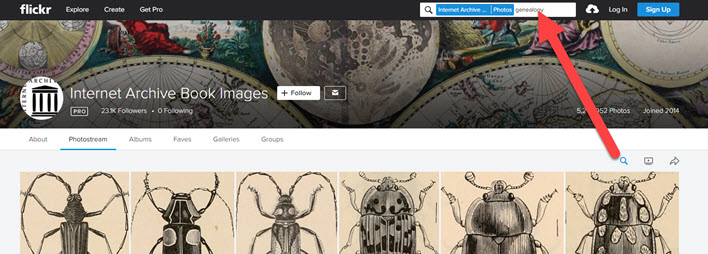
Location isn’t Everything: Just like with brick and mortar libraries, don’t let the location of the library or archive hosting the photostream fool you! Their collections are not limited to only items in their area. If you’re in search of something specific, try the Flickr Advanced Search page here.
Understanding Downloading and Copyright: Those who post images to Flickr Creative Commons offer different rights to those who want to download and use their images. Described here (and searchable here by the kinds of rights you want), those rights may include the ability to use a photo as long as it’s for noncommercial purposes and proper credit is given. Perfect for a responsible, source-citing genealogist!
10 Favorite Flickr Photostreams with Historical Focus
It would be impossible to list all of the potential photostreams at Flickr’s Creative Commons that feature historical photos, so I won’t even try. However, I’m happy to provide this list of favorites, which illustrates the breath and depth of possibilities. I hope it inspires you to search out your favorite library or archive at the Creative Commons.
(Organized by number of photos)
Internet Archive Book Images
5,240,000+ Photos
Though not currently organized by Albums or Galleries, there is something here for absolutely everybody! Use the search feature to zero in on what you want. (See tips section below)
The British Library
1,000,000+ Photos
A gloriously eclectic mix of images. Just one example: World War I: The Canadian Experience. This photo album covers 1895 and 1924, and contain depictions of Canadians’ experiences of the First World War. From the British Library: “Either produced by photographers on home soil or individuals in Europe employed by Lord Beaverbrook’s ‘Canadian War Records Office’ the photographs provide a wide ranging account of the many Canadians involved in and impacted by the war.”
The National Archives UK
20,000+ Photos
the UK government’s official archive contains more than 1,000 years of history, so their photostream is not to be missed! Nicely organized into Albums focused on location, the images offer a sampling of their massive holdings.
The U.S. National Archives
16,500+ Photos
Nicely organized into a vast array of albums, these photos represent only a small sampling of the photographs in their collection which totals more than 25 million photos and 20,000 graphic images. Early on they focused on uploading photos from the Women’s Bureau, the Environmental Protection Agency, and a few staff favorites. According to the National Archives, “These photographs, most taken by agents of Federal agencies over the years, cover a wide range of subjects and themes documented in the work of the United States government. Higher resolution versions of many of these images can be obtained from the U.S. National Archives by following the links located below each image.”
SMU Libraries Digital Collections
10,000+ Photos
Southern Methodist University Digital Collections includes the digital libraries and online digital collections from the six SMU Libraries. You’ll find an emphasis on digital collections of Mexican photographs, locomotives, Texas history, art, and currency notes, and more.
National Library of Norway
3600+ Photos
These images either fall in the public domain or the copyright belongs to the library and has been wavered. You’ll find photos, postcards, stereograph cards and other ephemera depicting life in Norway. With all of the portraits you may just spot an ancestor!

National Library of Norway photostream
The New York Public Library
2500+ Photos
Considering how many Americans passed through New York, this photostream is definitely worth a visit.
National Library of Ireland on The Commons
2500+ Photos
Here you’ll find a range of items from the Ephemera Collections of the National Library of Ireland. They provide a snapshot of different periods in Ireland’s social, political, economic and cultural history. They’ve also added items from their Manuscript collections, Prints and Drawings, Exhibitions, as well as photos from Library Events.
UBC Library Digitization Centre
of the University of British Columbia
2400+ Photos
Just one of many Canadian library photostreams, the UBC Library shows off it’s diverse image collection in well organized albums. My personal odd-ball favorite is the Tremaine Arkley Croquet Collection!
Library Company of Philadelphia
1280+ Photos
They’ve organized their current photo collection into more than 50 albums, making it easy to quickly spot the historical collections. Notable albums feature unique historical images from the Civil War era.
by Lisa Cooke | Jun 12, 2019 | 01 What's New, Genealogy Gems Podcast |
with Lisa Louise Cooke
June 2019
Listen now, click player below:
Download the episode (mp3)
In this episode:
- The story of Roy Thran
- Writing your story with author Karen Dustman
- Lisa’s adventures in England
Download the show notes PDF
Please take our quick PODCAST SURVEY which will take less than 1 minute. Thank you!
GEM: The Story of Roy Thran
Have you thought about telling the story of your personal history? Most of us have at some point, but it can seem easier to research the stories of our ancestors than to weave together our own. I’ve spoken to a lot of genealogists through the years and I often hear comments like “My story isn’t all that interesting or important.” But nothing could be farther from the truth.
When we don’t tell our own story, we not only take a big risk that the memory of our life will be lost down the generations, but we rob our family and our community of an important piece of their history.
Karen Dustman is the author of the book Writing a Memoir, from Stuck to Finished! She’s been helping folks capture and record their stories for several years in her community in the Sierra Nevada, which spans Central and Eastern California into Western Nevada. She’s known widely there as a local historian, writing on her blog and in the local newspaper about the history of the area.

 Writing a Memoir from Stuck to Finished! by Karen Dustman
Writing a Memoir from Stuck to Finished! by Karen Dustman
It was actually Karen’s story of the history an old house in the Carson Valley that shed light on the fact that one of its inhabitants was at risk of being forgotten. And no one wants to be forgotten.
In this episode, we travel back to 1925 to a sparsely populated ranching community to hear the story of 10-year-old Roy Thran. We’ll hear about his life and death, and how his story tentatively made its way through the generations of the family in one simple box all the way to the hands of his great grand-niece Krista Jenkins.
It was Krista who connected the all-important dots, eventually culminating in a museum exhibit that is now telling an important part of the Carson Valley history and touching the lives of its residents. In addition to Karen Dustman, you’ll hear from Krista Jenkins herself and Carson Valley Museum trustee Frank Dressel. My hope is that Roy’s story will transform your thinking about sharing your own story.
PART ONE: The Missing Boy
Last Fall, Krista Jenkins stumbled upon an article featuring a house she knew well. It was the home her grandmother grew up in, a beautiful white two-story home nestled on a ranch in Gardnerville, about an hour south of her home in Reno, Nevada.
The blog post called The Tale of the Thran House – and an Old Trunk was written by Karen Dustman, a local area historian and author.
It featured the story of Dick and Marie Thran, German immigrants who came to the Carson Valley in the late 19th century, and the four children they raised there, including Krista’s grandmother, Marie.
What jumps out at many readers about the blog post is the photograph of the beautifully restored German steamer trunk complete with heavy black ornate hardware, very likely the trunk that Krista’s great-grandmother had traveled with from the old country. The trunk had been discovered by the current owners in an old shed on the property, dirty and filled with auto parts.
But for Krista Jenkins, what jumped out was what was missing from the story: a little boy named Roy, the 5th and surviving Thran child.
Author Karen Dustman explains how the two women connected.
Karen: “I had mentioned the names of the four surviving children of this couple who lived in this house. But this relative reached out to me and said, ‘Did you know that there was this other child that they had named Roy?’
I was really curious, so we got in touch. She told me not only about Roy and his life, but that she had this amazing box. The family had kept this little boy’s possessions all these years after he died, and she had become the custodian of this box. So, she asked if I wanted to see it and of course I wanted to see it!”
The box contained the young Roy Thran’s childhood, a time capsule of sorts filled with the books, toys, and trinkets representing his interests and activities. In a sense, it was a boy in a box.

PART TWO: The Birth of Roy Thran
Roy Thran was born Wednesday, June 10, 1925.
The folks in the Carsen Valley of Nevada were flocking to the new Tom Mix movie North of Hudson Bay playing at the Rex theater in town.
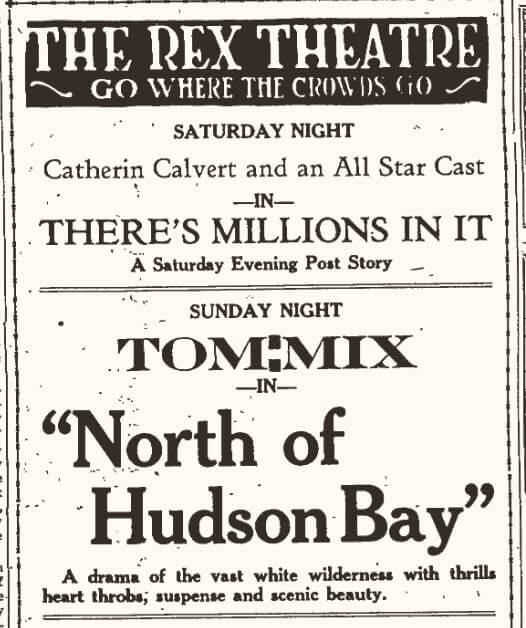
And everyone was looking forward to the big Carsen Valley Day Dance to be held that Saturday night at the CVIC Hall in Minden. Everyone, that is, except Anna Sophia Marie Thran, simply known as Marie. (Photo below)
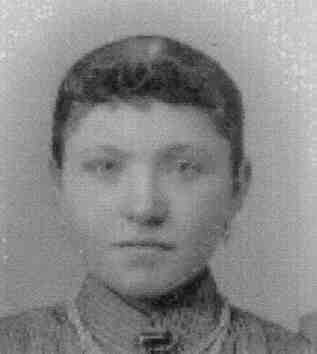
A native of Hannover, Germany, Marie was in the last weeks of her pregnancy and was happy to deliver before the hot summer weather was in full swing.
She had reason to be apprehensive about this birth for several reasons. A 48-year-old mother of four, she was on borrowed maternity time with this late arrival. Her last surviving child was born in 1901 and since then she had suffered the loss of three more children, including little Katie Frieda who lived just three months.
Marie’s husband Diedrich Herman Thran (photo below), known around town as Dick, was 14 years her senior. Also a Hannover native, according to the 1900 census, Dick had immigrated in 1881 and became a naturalized citizen.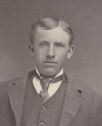
Dick saved the money he earned working for ranchers in the area and at the age of 30 returned to Germany to find himself a wife.
In 1895 he returned with seven other Germans and most importantly, the beautiful Anna Sophia Marie Dieckhoff, his fiancé, on his arm. Within the month they exchanged vows at the home of Dietrich’s brother Herman. That was back on another lovely June day, the 29th of June 1895 on which the hard-working Dick presented her with a lavish wedding gift: a beautiful horse and buggy.
Lying there in her bed in the enchanting white two-story home on Dressler Lane fashioned after the grand homes of their native land, Marie gave birth to their son in 1925.
Author and local Carsen Valley historian Karen Dustman: “Roy’s birth must have been quite a surprise for Marie, especially after losing three children in the intervening years. I’m guessing it was a very happy surprise this late in life, and he was certainly welcomed into the family. They had a christening ceremony for him at the local Lutheran church on June 21, 1925, so eleven days after he was born.”
Thran descendant Krista Jenkins: “Because Roy was a late baby, my great-grandmother coveted this little guy. It was the joy of their life at this point.”
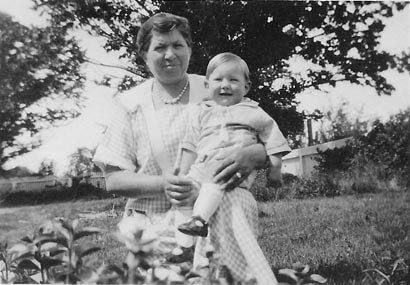
Roy’s childhood
Roy grew up like many sons in the Carsen Valley at that time, likely carrying some responsibilities around the ranch, but also living a fairly free-range life. Historian Karen Dustman explains:
“Roy was born and grew up in the late 1920s and early 1930s, so he would have been part of a wonderful rural farming community here. And of course, he would have lived in the beautiful Thran house on his parents’ dairy ranch. And both of his parents were German as we talked about from the old country, so I imagine they were a little bit strict. And I would imagine he would have had chores to do on the ranch. But as the baby of the family, I’m picturing him doing less than the other kids in terms of chores. He went to the elementary school in Minden nearby where he would have gotten to know all the other ranchers’ kids.”
In the Thran family a few handed-down stories confirm this.
Krista: “It was your typical ranching family in the early 1900s where everybody pitched in and worked. And little Roy came along, and he was handed down the little toys that somebody else had in the family. And from descriptions that we’ve been told as far as my generation, is that he was just a happy-go-lucky little kid, liked to pitch in and work, and just very kind of a jolly good little guy.
He got relatively good grades in school and was conscientious, and just kind of the love of my great-grandmother and grandfather’s life at that point.”
But it’s really the box of Roy’s possessions that tell us a more complete story of his childhood.
“He had those classic metal toy trucks to play with and watercolor paints. We know that he played Tiddledy Winks with his friends, and marbles. One of the other things that he had as an item in his box was a homemade sling shot that somebody had carved out of a fork branch, so I can picture him out there trying to hit things with the sling shot.
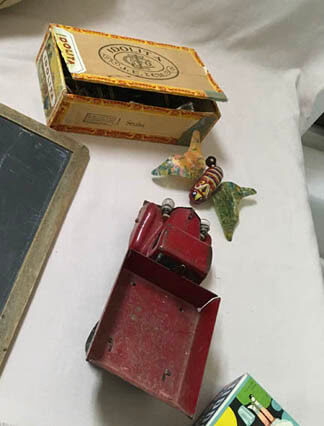
We know that he played baseball, and someone had hand-carved a wooden baseball bat for him, if you can imagine. It wasn’t even perfectly round. It had these flat sides on the baseball bat so you can imagine it must have been really hard to hit the ball in a straight line.
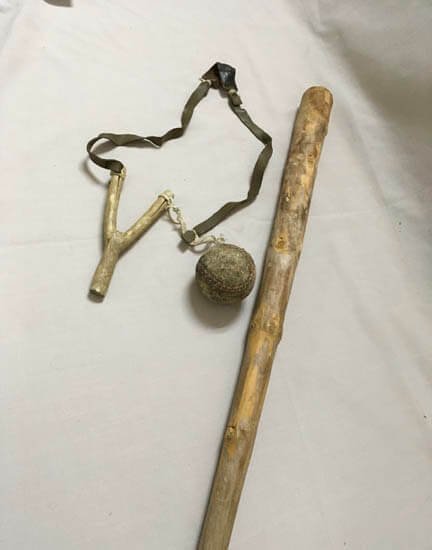
And then one of his sweetest possessions that I really like is he had a stuffed toy rabbit that he must have carried around as a toddler. And it looks like one of those homemade things. Women back then used to buy a printed pattern that was on cotton cloth, and they’d cut it out and stuff it. The moms would sew around the edges and put stuffing inside. And this was a really stained and well-worn toy, so I just picture him carrying around this little stuffed rabbit as a child.”
Roy was also enamored with the great aviators of the day. He joined the Jimmy Allen Flying Club for kids, which came with an official acceptance letter, a bronze pin featuring “flying cadet” wings, and a silver pilot’s bracelet.
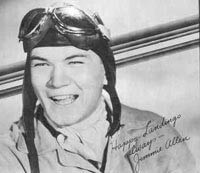
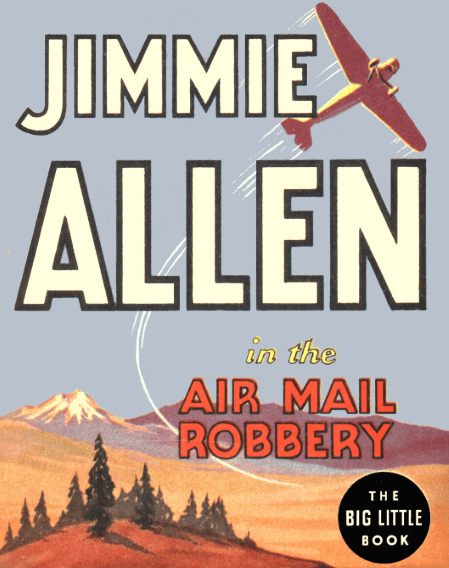
In the box was also a treasured pint-sized version of the aviator cap that Charles Lindbergh wore on his history-making solo flight across the Atlantic Ocean in 1927.
The Premonition
One day in 1935, ten-year-old Roy entered the kitchen where his mother was working. But this was no ordinary day.
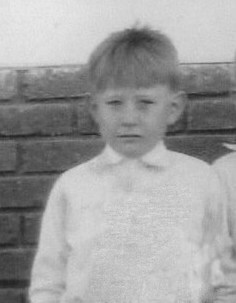
Krista: “Well, the story in the family is that my great grandmother was in the kitchen with my grandmother (her daughter), and little Roy walked in and my great-grandmother kind of shrieked a little bit, and written across his forehead was something in the order of ‘I won’t be here much longer.’”
Sometime after this unusual event, early on the afternoon of August 6, 1935 Roy headed over to his friend Henry Cordes’ home to pick up some Sunday school papers that he had left in the car. While visiting, Roy and Henry’s older brother, twelve-year-old Roy Cordes decided to head out on horseback for a ride. Around 4:00 they stopped to eat lunch and then, even though by all accounts from the family Roy hated water, they decided to make their way to the dam on the Carson River to go swimming.
According to Roy Cordes’s account of the event to the local newspaper, “After undressing Roy Cordes admonished his chum to be careful because the water near the dam was deep. The words were hardly out of his mouth when his chum stepped into deep water and disappeared. Neither of the boys could swim, but young Cordes made a heroic attempt to save his companion and came within an ace of losing his own life as he frantically grabbed for his chum.”
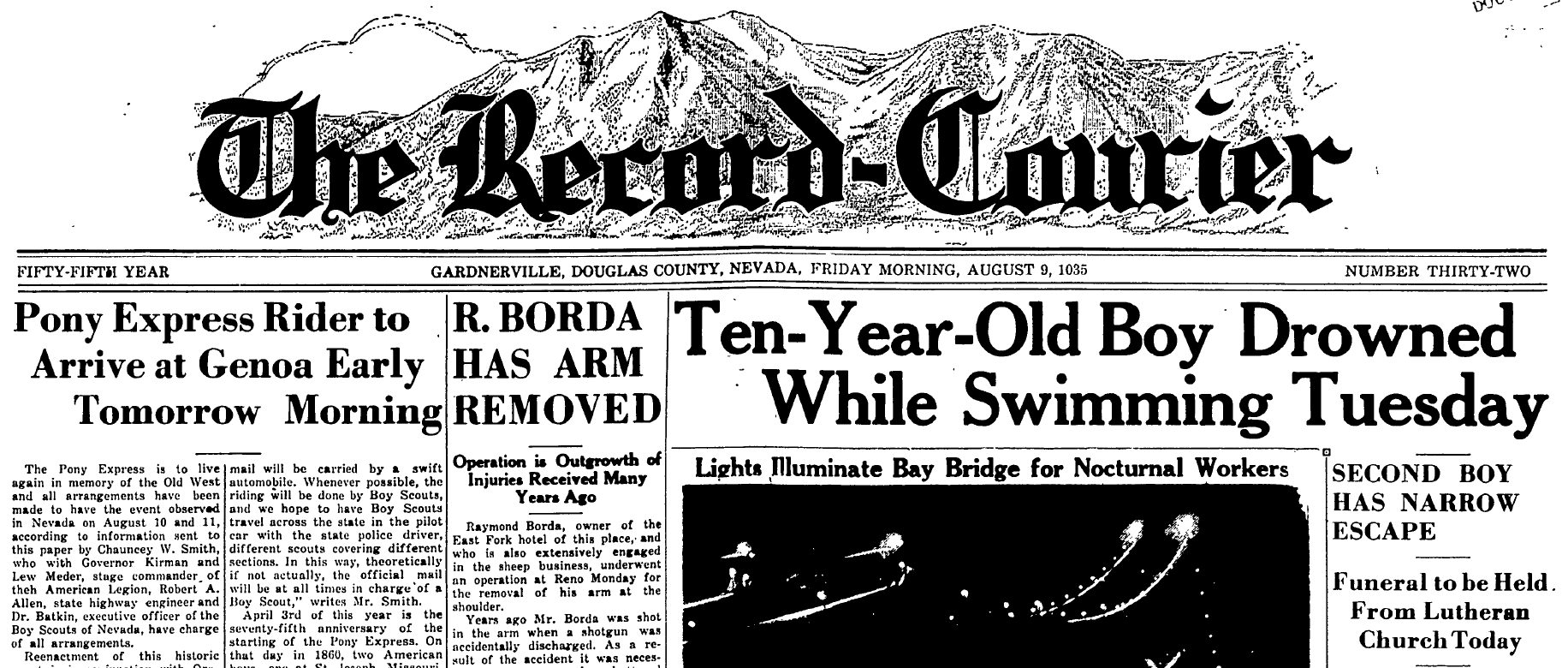
Realizing that he was helpless to save his friend, young Cordes hurriedly dressed, mounted his horse and rode at top speed into the home of his father and notified him of the tragic event. Mr. Cordes drove to the Thran ranch, telling the parents of the boy what had happened.
Krista: “Subsequently my Uncle, which would be Roy’s brother Carl, jumped in and he’s the one who found Roy’s body. And they pulled it out on the bank and tried CPR for quite a while, and it wasn’t working. So, he passed away there. But Roy’s brother Carl is the one who drug him out.”
(Image below: Roy Thran’s death certificate)
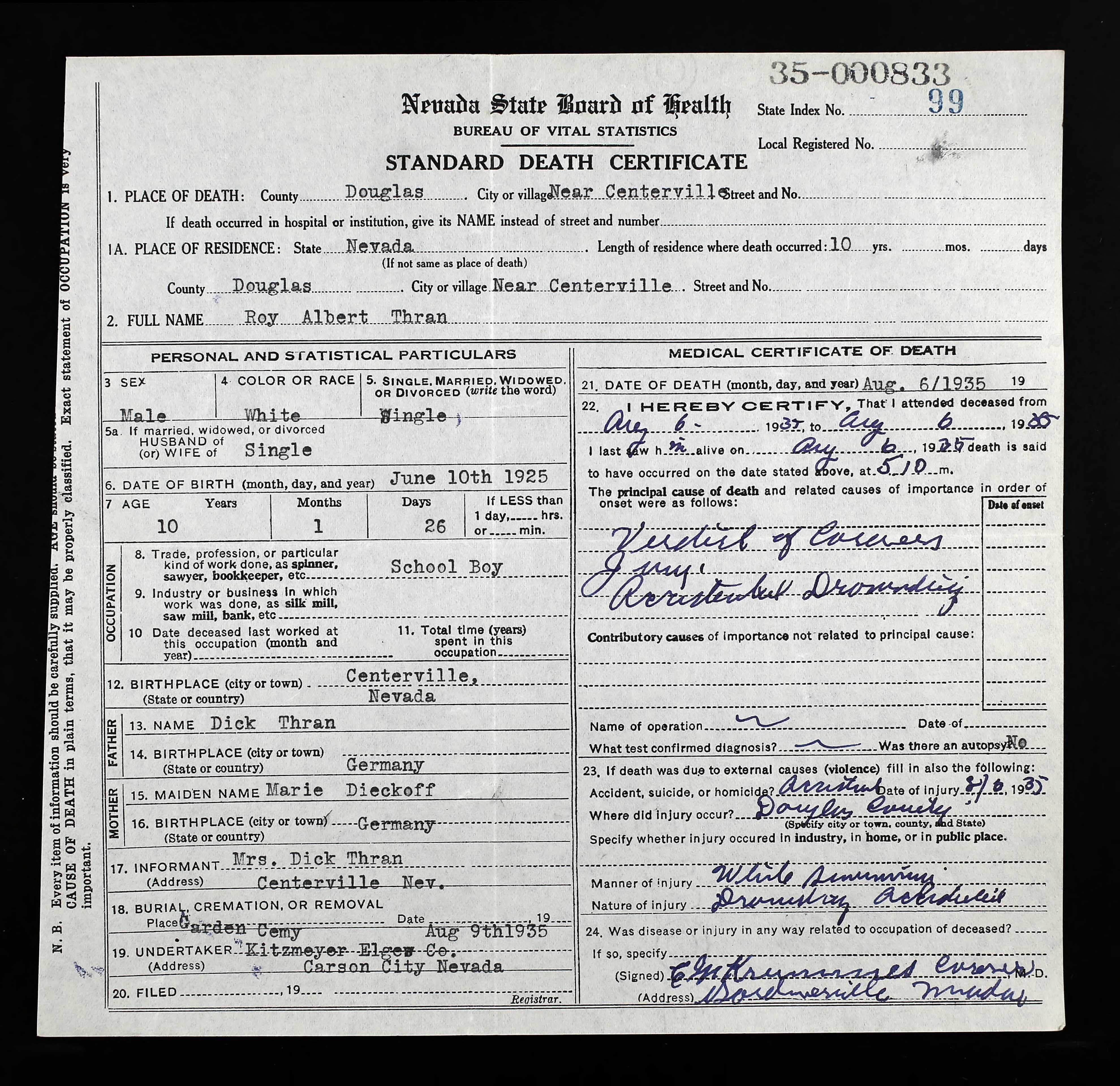
PART THREE: A Life in a Box
After Roy’s tragic death, Roy’s mother Marie carefully collected not only his prized possessions like the aviator’s cap, but also some of the last things he would have personally used like his school slate and a small collection of books. They were placed in a box, and by all family accounts, Roy wasn’t spoken of again. That is, until years and generations later.
Krista: “When my Grandmother Marie’s brother died, who was Carl, who was also the brother of Roy, he died in the early 80s I believe, my grandmother was in the family house, and they were cleaning out the belongings in this house. And that was where she was raised, and of course Carl was also, and Roy. (Photo: Roy’s sister and Krista’s grandmother Marie Thran Cordes)
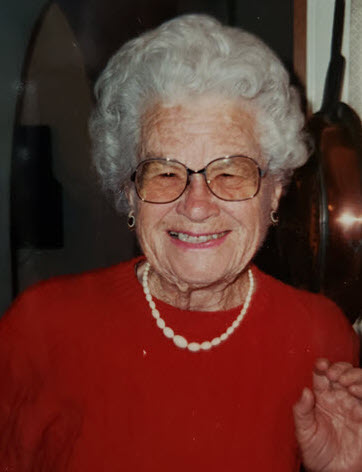
In the back portion of my great-grandmother’s closet was this box. My mom was there along with my aunt. And my grandmother came out of this closet area, and we don’t know why, gave this box to my mother with the instructions ‘make sure Krista gets this box.’ And so, they went on about their business. My mom, whenever we got together shortly after that, my mom said, ‘Oh, I have something for you from Grandma.’ So, it was this box, and we started going through it. And at that time, I didn’t know that little Roy had ever existed.”
In such a short period of time, one leaf on the family tree had grown dangerously close to being forgotten. And Krista learned very quickly how important it was to gather the stories of her elders.
Krista: “We started going through all of his belongings, and we kind of pieced together this story, and that’s when we kind of started figuring out ‘Oh my God!’ My mom remembered because she was told the story as a little girl growing up that these were Roy’s belongings.
You know, as time went on, the funny thing, and maybe this is what happened in these prior generations, is nobody really talked about Roy. In fact, I just read an article that my grandmother was interviewed in a long time ago, and she spoke of growing up and working on the ranch and such, and she didn’t even mention Roy. So it’s just maybe that generation was, you know, ‘He passed away,’ and they just parked him. Or again, speculation, maybe that was such a traumatic event for the family that they just decided to park it. That could be a generational thing that long ago. But it’s not like, you know, ‘Talk about Roy!’ It was just never really brought up.”
(Click here to read the article about Marie Thran Cordes.)
Over the years Krista kept the box and gathered the remaining family stories about Roy, really restoring him to the family tree. So, on the day that she came across Karen Dustman’s article about the Thran house, she seized the opportunity to restore him to the community’s history.
Karen: “She was wanting to know if I’d be willing to write a story about Roy and his box. And also, whether our local museum would be interested in maybe doing an exhibit of his things. So, we arranged to meet up at the museum with the museum curator, and thankfully Gail is wonderful. She was as excited and thrilled as I was about the box. And I said I would of course love to do a follow up story about Roy and his box. Gail welcomed the idea of an exhibit at the museum and made the arrangements and space for it to happen.”
Taking items on loan rather than as a donation was a rare occurrence for the Carson Valley Museum. But Museum Curator Gail Allen felt it was worth a closer look, and Douglas County Historical Society Trustee Frank Dressel whole-heartedly agreed.
Frank Dressel: “Krista brought the box in and they kind of analyzed the different things, the different artifacts of Roy’s, as far as with his childhood, the stuff that was in the box that they found in the attic. It’s a local story. It’s a great story. The box has all kinds of treasures as far as this life of Roy Thran.”
Krista: “And as I started bringing stuff out of this box, everybody was enamored. They were just like “Oh, my God!” And it just sort of fell into place.”
Frank: “And they weren’t ready to donate it to the museum. And the big thing about the museum is that we don’t like to take things on loan because of the responsibility and everything else. But with this being a local exhibit, what we decided to do was to have it on exhibit at the museum for a year.”
Karen: “Krista and her aunt Lois Thran worked together to assemble the exhibit and physically put it in place. There was also a curator who was really, really helpful and she involved an exhibit’s coordinator to help get the display cases arranged and do what he could. But really it was the two family members who put the display together and did a beautiful job. They have two tall glass cases devoted just to his exhibit, which is really a tremendous amount of space. And it’s this little snapshot in time of just amazing things. The people who have come to look at it have just been so impressed with the exhibit. They did a beautiful job of it.”
Krista: “My aunt, who’s my mother’s sister, her name is Lois Thran, she had a florist business for a long time. In fact, it’s still in the family. Her granddaughter is running it now. And so, my aunt is just really good at putting things together. I mean, I can put stuff on a shelf, but my aunt kind of has that ability to design. My mom lives in Reno, and I asked my aunt, and she’s like ‘Yeah, I’ll help you!’ So, we put stuff there, and she’d go behind and she’d rearrange it, and she’d look at it and rearrange it. So, we didn’t just put stuff on a shelf. My aunt just kept moving things around and moving things around, and it just had some continuity. And that’s why we kind of drug her along. That and the fact that this was her uncle, really, and she got to participate in his story too.”
Roy’s story was quickly becoming the family’s – and the community’s – story. His childhood possessions are transforming how people think about the importance of the story of every life, even one that spanned only a decade.
The exhibit drives home the idea that everyone’s story is important, and really connected to everyone else’s story. You can just hear the enthusiasm in Frank Dressel’s voice as he describes and connects with the items that were so precious to Roy Thran.
Frank: “Well you know the big thing that caught me was the hand-written letter to a friend, looking forward to him visiting over the summer vacation and such. It’s just, that‘s how they communicated back then. And you can just tell how excited he was about his friend coming to visit for the summertime.
You know, the way kids are raised today with cell phones and everything like that, this boy didn’t have any of that back then. You know, it just shows the lifestyle here in the Carson Valley.”
Krista: “This is such a small community and you know life as we know it is changing on a daily basis. The old timers are leaving us, and it’s important, I think, that we don’t lose sight of history of our own families, or the history of the area that you’re living in.”
Karen: “I was really touched that the family wanted Roy’s story to be told and I was just really pleased that I was able to share his story and put that up on the blog. But the really big contribution was by the family coming forward and sharing his story. I just thought it was neat that this tragic event ultimately had a really positive outcome.”
Resources:
The Douglas County Historical Society,
1477 Old US 395 N Suite B
Gardnerville, NV 89410
http://historicnv.org
The free podcast is sponsored by:

GEM: Writing Family Stories with Author Karen Dustman
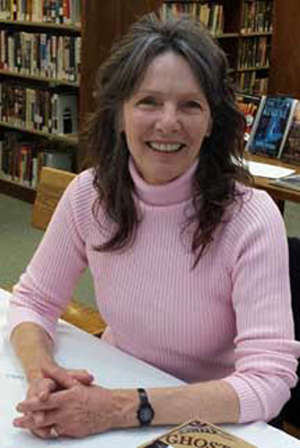
Why she wrote the book and what she hoped hope people would get out of it:
As a way to share her experience in sharing oral histories. After her mother’s unexpected death, she regretted not collecting more of her mother’s stories.
“It’s important, don’t wait. Get it done while you can” Karen Dustman
Everyone has great stories to tell. How do you help people find them?
Your family wants to the know the simple stories of how things happened, like how you met your spouse.
Involve a second person, someone who can ask you questions. Ask them what they would like to know about her life.
Why do you think stories are so healing?
You have a chance to look back and put things in perspective, which can be very freeing. As time passes the sweetness comes out. Remember, it’s not just one tragic event, but it’s a whole lifetime of events.
It can also be a way to take the monsters out of the closet. In Roy’s case, the family was able to go from sorrow and bitter grief (literally, all kept in a box!) to finding a way to celebrate and share his life. It was so good. Like they hadn’t known what to do with this sad tale, and now everyone finally could breathe a sigh of relief. They were able to come together and make the exhibit happen.

For 20 DOLLARS off, visit storyworth.com/gems when you subscribe!
What are some of the most common stumbling blocks that people face in telling their own stories?
Often it is “Where do I start telling my story?”
Find one single story you are excited about, hopefully a happy one, to get you started and make the scope a little smaller. Finish that one story and then keep on going.
There are also the practical issues: what if you don’t type well? What are the mechanical difficulties?
Karen recommends:
“It’s so important to capture those stories while we still have family who can tell them.”
Karen recommends that you “picture the words flowing freely for themselves and seeing it happening.”
In the first chapter of her book she discusses getting your mental game in gear. Realize it is possible. Rehearse it in your mind, and picture it happening and the words flowing freely. Imagine that you’re going to have a good time!
Reach out for help and encouragement. If you can share a little piece of your writing, you will get tremendous feedback from people, which can give you motivation.
“Do it now because there’s really no legacy you can leave that’s more important than that.”
Why did you create Clairitage Press?
My mom was the motivating reason. I tell her story in my Memoir book — how my one real sadness is that I never got her full story, because she died suddenly and quite unexpectedly. But then I did find 12 handwritten pages later that she had left among her papers, talking about her life, which are so precious.
Here is her story on Karen’s blog, and a photo of her as a child. Interestingly, she was about age 7 in this photo and she was born in December 1927, so this would have been taken roughly about the time that Roy Thran died!
The author of 10 local history books and many family histories, Karen says “I’m all about preserving history and honoring family.”
Visit Karen Dustman at Clairitage.com > Blog
Click here to order a copy of Karen’s book Writing a Memoir from Stuck to Finished!
The free podcast is sponsored by:
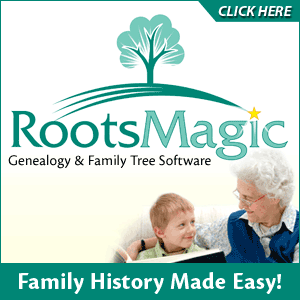
GEM: Lisa’s Recent Adventures in England
This month I keynoted at a brand new genealogy conference called THE Genealogy Show. It was held at the NEC in Birmingham, England, the same location where the Who Do You Think You Are? Live conference was held before it folded.
It was a success with hundreds of genealogists attending and Kirsty Gray and her board members including DearMYRTLE here in America are already planning the next conference for June 26 & 27 of 2020 in Birmingham
Mentioned in this Gem:
Nathan Dylan Goodwin Interviews and books

Michelle and Jennie
These two ladies were waiting for me at the entrance of my first session, Time Travel with Google Earth. (Also available on video with Premium membership.)

“My friend Jennie and I are addicted to your website, podcasts and all you teach. As we said [at] the show we are postgraduate Diploma Students at Strath and whenever we get stuck we say “what would Lisa do….” We are thrilled you came over to the UK and any chance we get we spread the word.”
Lorna Moloney
Owner of Merriman Research and producer and host of The Genealogy Radio show aired from Kilkee, Ireland on a weekly basis on Thursdays at 4 PM in Ireland and it’s available as a recorded podcast.
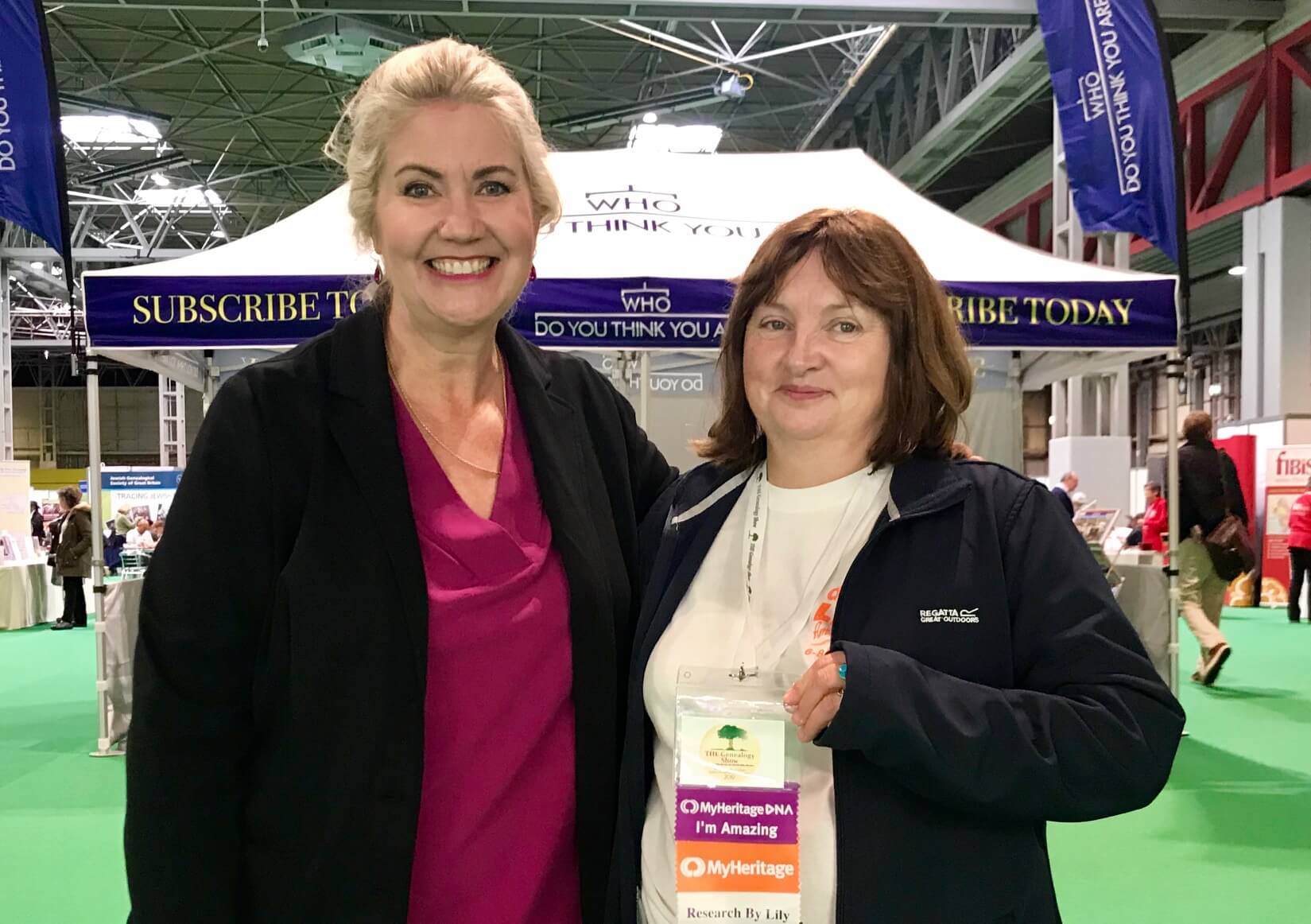
Bill and I celebrated our 35th wedding anniversary at these lovely locations in England:
- Blenheim Palace – Birthplace of Sir Winston Churchill.
- Chatsworth – Jane Austen’s inspiration for Mr. Darcy’s house in Pride and Prejudice.
- Lyme Park – Used for the exterior shots of Mr. Darcy’s home, Pemberly, in the 1995 A&E Pride and Prejudice mini-series.
- Sudbury Hall – Used for the interior shots of Pemberly.
- Haddon Hall – Wonderful example of Tudor living. The Princess Bride and Pride and Prejudice filming location.
- Kedleston Hall
- Calke House –I’ll talk more about in the next Premium Podcast episode
We stayed at Dannah Farm Country House in Shottle, Derbyshire. Say “hi” to Joanne and Martin for me!
You can see photos and videos from my trip on my Instagram page.
Become a Genealogy Gems Premium eLearning Member
Gain access to the complete Premium Podcast archive of over 150 episodes and more than 50 video webinars, including Lisa Louise Cooke’s newest video The Big Picture in Little Details. Learn more or subscribe today here.
by Lisa Cooke | May 23, 2019 | 01 What's New, Genealogy Gems Podcast |
with Lisa Louise Cooke
May 2019
Listen now, click player below:
Download the episode (mp3)
In this episode:
- Two listeners shares an exciting find using Lisa’s research strategies
- Lisa provides next steps on German research in response to a listener question
- Your Master Family Tree, and Sharing Branches Online Explained
- The unusual history of one of the earliest forms of the World Wide Web
Download the show notes PDF
Please take our quick PODCAST SURVEY which will take less than 1 minute. Thank you!
NEWS:
Lisa Louise Cooke is back in the studio after two weeks on the road speaking at the Ohio Genealogical Society (OGS) Conference and the National Genealogical Society (NGS) Conference.
Each conference was great and had its own unique feel, and there were many new genealogists in attendance.
Genealogy Gems listener Carol stopped by and enthusiastically shared with how the eBay search strategies for family history that Lisa discussed in episode 140 paid off in a big way!


MAILBOX:

Robin wrote in to share how Sydney Orton’s song with her grandpa in Genealogy Gems Podcast episode 228 brought her to tears in a toll plaza while driving!
Steve wrote in to rave about the value that his new Genealogy Gems Premium eLearning membership has brought to his family history research.
Rylee says she’s grateful to have found the podcast and she shares a story of genealogical discovery that she hopes will inspire others. Rylee asks “How do I find sources for these people? I have searched all over ancestry and Family Search and have had no luck again. I really want to believe that the people I have as Adam’s parents and siblings all the way through his 2nd great-grandparents (paternal) are truly his family but I need to get more information. Where can I go for help with German records and where can I continue my search?”
Lisa’s comments: You’re absolutely right, what you found are just hints. It sounds like it’s time for you to move on from the “Genealogy Giants” (Ancestry, FamilySearch, etc.) and into German records websites, libraries, and archives to find real sources that nail down the family tree.
Lisa recommends the Genealogy Giants quick reference comparison guide.
We have several articles and episodes at Genealogy Gems that can help you do this:
- Go to genealogygems.com
- At the top of the home page select “German” from the “Start Learning” drop down menu
- That will take you to these results pages featuring our German research strategies.
I’m optimistic for you because Germans are known for keeping excellent records, and I have had good luck in searching them.
GEM: Your Master Family Tree, and Sharing Branches Online Explained

I describe it this way: Plant your tree in your own backyard and share branches online.
A master family tree has three important characteristics:
- It is owned and controlled by you.
- It is the final say on what you currently know about your family tree.
- It is protected with online backup to ensure it is safe.
Plant Your Master Family Tree
Lisa uses RootsMagic software for her master family tree. Learn more about GEDCOM files in this article: GEDCOM File (What is It & How to Use This Genealogy File)
Protech Your Master Family Tree
Lisa uses Backblaze to back up her master family tree and computer. Visit www.backblaze.com/lisa
(Using this link also helps keep this free podcast free. Thank you!)
Read more: How to Download Backblaze in 4 Easy Steps

Share Branches Online
Genealogy Giants Guide available in the Genealogy Gems store.

Read Lisa’s article: Planting Your Master Genealogy Family Tree for all of the strategies mentioned in this episode.
The free podcast is sponsored by:


PROFILE AMERICA: Friday, May 24th, 2019
In a way, today marks the 175th birthday of the World Wide Web. Only it was electro-mechanical, not digital. On this date in 1844, Samuel F.B. Morse activated the first telegraph line, sending a dots-and-dashes code message from the U.S. Capitol building to a receiver in Baltimore.
By the late 1850s, the first telegraph cable had been laid across the Atlantic Ocean, and in 1861, the telegraph spanned the continental United States. Over the ensuing decades, the wires wrapped around the world.
From the 1844 demonstration, telecommunications today has grown into a half-trillion dollar a year industry, and employs more than 1 million workers in over 59,000 industry establishments.
You can find more facts about America from the U.S. Census Bureau online at www.census.gov.
Sources:
Joseph Nathan Kane, Kane’s Famous First Facts, Fifth Edition, H.W. Wilson Co., New York, NY, 1997, #7692.
Become a Genealogy Gems Premium eLearning Member

Gain access to the complete Premium Podcast archive of over 150 episodes and more than 50 video webinars, including Lisa Louise Cooke’s newest video The Big Picture in Little Details.
Learn more here.
(Membership doesn’t auto-renew because we don’t like that either. Prior to your membership expiring you’ll receive a friendly reminder email from us.)
Genealogy Gems App Users
Don’t miss the bonus content in this episode. Tap the “gift” icon on the episode screen in the app.
Get the app here or search for “Genealogy Gems” in your device’s app store.
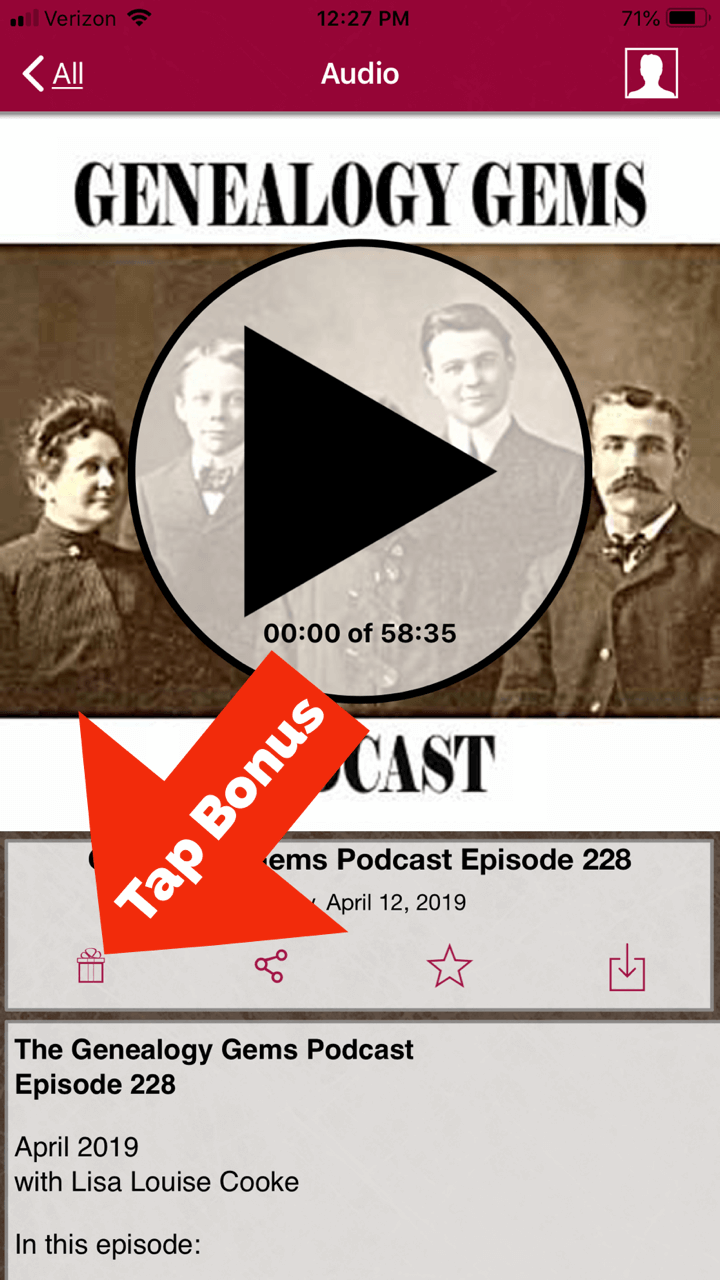
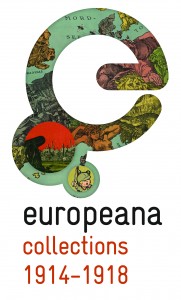 Europeana is a digital doorway to European cultural heritage that everyone with European roots will find interesting and enlightening.
Europeana is a digital doorway to European cultural heritage that everyone with European roots will find interesting and enlightening.





































